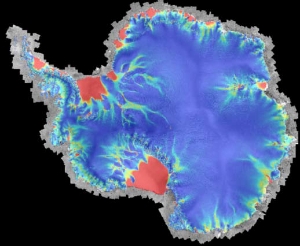Did you know that glaciers at the edges of the Antarctic ice cap flow like sluggish rivers towards the coast?When the glacier reaches the sea, the ice starts to float. This huge, thick floating tongue of ice is called an ice shelf.

The ice shelf holds the glacier back, like a cork in a bottle, and prevents more ice from flowing down to the sea. In some places the sea is so shallow that the ice shelf runs aground on the seabed; this can be seen as a huge bump on the surface and is called an ice rise. These ice rises help impede the glacier and hold the “cork” in place. ICE RISES is the title of a research project to examine ice rises on ice shelves along the coast of Dronning Maud Land in Antarctica. In December this year, a research team from the Norwegian Polar Institute will travel to the Fimbul Ice Shelf in Antarctica to try to figure out how ice rises influence what happens to the rest of the ice. The team will study how the ice rises and the coastal areas have developed over the past millennia, whether they have grown or shrunk. The field work will be done over the next three Antarctic summer seasons. The researchers will examine how the ice moves in a complex system of glaciers, ice rises, and ice shelves. The research findings will be used to predict melting of the ice and thus whether sea level will rise or not. The total amount of ice on the Antarctic continent is determined by the balance between new snow that falls on the ground, and ice that flows out to sea. The more ice that flows out to sea, the higher the global sea level will be, which in turn will affect all the people that live along the coast. |
South Pole 1911–2011 is an informational outreach project run by the Norwegian Polar Institute
Contact person:


